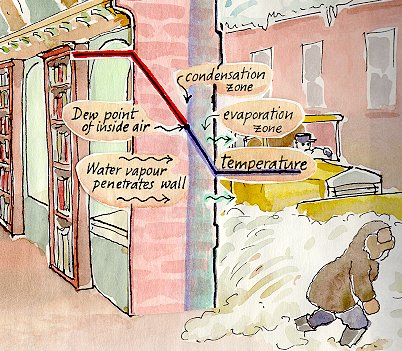
 |
Condensation in the walls of humidified buildings |
Many museums in temperate climates are humidified in winter to attain the unofficial standard of about 50% RH at a comfortable temperature around 20C. Air conditioned museums are also usually pressurised, to prevent unauthorised entry of air that has not been filtered and humidified. The inside air will tend to flow and diffuse out through the walls. As the air, together with its burden of water vapour, passes through the wall it will cool down. The relative humidity will consequently rise, if one assumes that water vapour moves at the same pace as the other constituents of air. We can use the atmospheric moisture calculator to show that air at 50%RH at 20C will reach 100%RH at 9C.
 On a cold winter day this temperature will be reached at some point within the wall. Water condenses there and may later freeze. The water will also dissolve salts and move them around in the wall and will accelerate corrosion of metal fittings within the wall. The process is shown in the diagram. The temperature gradient is drawn diagonally down through the wall section. The picture also hints at a process that partially counteracts this process: water can evaporate from the outer surface of the wall.
On a cold winter day this temperature will be reached at some point within the wall. Water condenses there and may later freeze. The water will also dissolve salts and move them around in the wall and will accelerate corrosion of metal fittings within the wall. The process is shown in the diagram. The temperature gradient is drawn diagonally down through the wall section. The picture also hints at a process that partially counteracts this process: water can evaporate from the outer surface of the wall.
Another process that modifies this simple picture is that water vapour and air do not generally move at the same rate through a porous wall. Water is absorbed into the bricks, for example. If the low temperature is just a short, overnight event, the bricks may well have the capacity to prevent condensation from the limited amount of air that can pass through in this period.
Deposition of water in the wall is therefore dependent on several competing processes: diffusion of air through the porous wall, flow of air through cracks in the wall, absorption of water into the hygroscopic brick and finally, mixing of the humid air originating from inside the building with outside air in the outer layer of the wall.
 Engineers have responded to this threat to the durability of the wall by inserting a barrier to air flow through the wall, usually a polyethylene foil. Other professionals in the building trade then make holes in the barrier to insert electrical cables, bolts, pipes and just nails. This has resulted in some spectacular failures of buildings that were designed with an attention to detail appropriate to constructing a jumbo jet but built in the more relaxed tradition of the building industry.
Engineers have responded to this threat to the durability of the wall by inserting a barrier to air flow through the wall, usually a polyethylene foil. Other professionals in the building trade then make holes in the barrier to insert electrical cables, bolts, pipes and just nails. This has resulted in some spectacular failures of buildings that were designed with an attention to detail appropriate to constructing a jumbo jet but built in the more relaxed tradition of the building industry.

This work is licensed under a Creative Commons Attribution-Noncommercial-No Derivative Works 3.0 License.